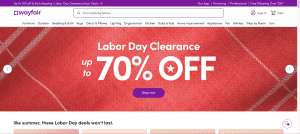
In the highly competitive business world, keeping an eye on your price competitors is crucial for the success of your own business. Monitoring the pricing strategies of competitors provides valuable insights into market positioning, trends, and consumer expectations, helping you make informed decisions.
According to the study ‘Competitive Intelligence and Marketing Effectiveness‘ by Ellen R. Goldman, companies that actively engage in competitive intelligence, including price monitoring, tend to achieve higher marketing effectiveness and strategic success.
In this comprehensive guide, we will explore the importance of monitoring price competitors and provide actionable tips on how to do it effectively.
Understanding the Competitive Landscape
Before diving into the reasons for monitoring price competitors, it’s essential to understand the competitive landscape in which your business operates.
Competitors can be direct, offering similar products or services, or indirect, offering different products but competing for the same consumer dollars.
By identifying your price competitors and analyzing their pricing strategies, you can better understand market dynamics and position your business strategically. This knowledge helps in capitalizing on opportunities and mitigating threats, ensuring you remain competitive.
Identifying Market Trends and Pricing Opportunities
One of the key benefits of monitoring price competitors is the ability to identify market trends and pricing opportunities. By keeping an eye on competitors’ pricing strategies, you can spot emerging trends, seasonal price changes, and innovative pricing models that you can leverage for your own business.
For example, if a competitor offers discounts during a specific season and gains traction, you can consider similar promotions to attract customers. Understanding these trends helps you align your pricing strategy with market expectations and consumer behavior.
Benchmarking Pricing Performance

Monitoring price competitors allows you to benchmark your own pricing performance against industry standards and best practices. By comparing your pricing metrics, such as average selling price, discounts, and price elasticity, to those of your competitors, you can identify areas where you excel and where you may need improvement.
Benchmarking helps set realistic pricing goals, track progress, and identify areas for optimization. It also provides insights into how competitors position their prices in the market and how you can differentiate your pricing to stand out.
Staying Informed About Industry Pricing Developments
In today’s fast-paced business environment, industries constantly evolve, with new pricing technologies, regulations, and consumer preferences shaping the competitive landscape. By monitoring price competitors, you can stay informed about these developments and trends that may impact your pricing strategy.
For instance, if a competitor adopts dynamic pricing based on real-time demand or launches a value-based pricing model, you can use this information to adapt your strategies. Staying informed about industry pricing developments helps anticipate challenges and address them proactively.
Protecting Your Market Share
Competition in pricing is fierce, and without proactive monitoring, you risk losing market share to more agile competitors. By keeping a close eye on competitors’ pricing activities, you can identify potential threats and take preemptive action to protect your market share.
For example, if a competitor launches a price-cutting campaign targeting your customer base, you can respond with competitive pricing strategies to retain customers. Quick reactions to price changes help maintain your market position and customer loyalty.
Improving Your Pricing Strategies
Monitoring price competitors provides valuable insights into how you can improve your pricing strategies. By analyzing competitors’ successful and unsuccessful pricing tactics, you can learn from their experiences and apply these lessons to your business.
For instance, if a competitor excels in implementing a tiered pricing model, you can study their approach and consider adopting similar tactics. Continuous monitoring and adaptation of pricing strategies ensure competitiveness and drive business growth.
The Importance of Automation

In today’s dynamic market, automation has become a key player in streamlining business operations. Pricefy, an automated price monitoring tool, offers a significant advantage in this arena.
Manual tracking of competitor prices is often a tedious and error-prone task. Pricefy transforms this process, delivering real-time data and insights with minimal effort. This shift not only frees up valuable time for more strategic activities but also ensures greater accuracy in pricing information.
By harnessing Pricefy’s capabilities, businesses can respond more swiftly to market fluctuations. This agility allows for timely adjustments to pricing strategies, helping maintain a competitive edge. In essence, Pricefy empowers businesses to stay ahead of the curve, turning price monitoring from a chore into a strategic asset.
With automated tools like Pricefy, companies can focus their energy on critical decision-making and growth initiatives, all while staying informed about their market position. It’s a smarter way to operate in today’s fast-paced business environment.
FAQs
- How can monitoring price competitors benefit my business?
Monitoring price competitors helps you understand market trends, identify opportunities, benchmark pricing performance, stay informed about industry developments, protect market share, and improve pricing strategies. - What are the risks of not monitoring price competitors?
Not monitoring price competitors can lead to missed opportunities, loss of market share, unexpected industry changes, and falling behind in pricing innovation. - How often should I monitor my price competitors?
Regular monitoring is recommended, depending on the industry’s nature and pace. This could range from daily monitoring for dynamic markets to quarterly or annual reviews for more stable markets. - What tools can I use to monitor price competitors?
Various tools, including competitive intelligence software, pricing analytics platforms, and industry reports, are available. Pricefy is probably the best for performance/price ratio. - How can I differentiate my pricing from competitors?
Focus on your unique value proposition, customer experience, product differentiation, and branding. Offering unique value can set you apart in a competitive market. - What are the ethical considerations when monitoring price competitors?
Ensure ethical monitoring practices, avoiding corporate espionage, false information, or intellectual property infringement. Maintain fairness and transparency in competitive analysis.
Potential Risks and Legal Considerations
While monitoring price competitors can offer significant advantages, it also carries potential risks that businesses must consider:
Legal Risks
- Antitrust Violations: Monitoring competitors’ prices could lead to antitrust issues if not handled properly. Engaging in price-fixing, collusion, or sharing sensitive pricing information with competitors can result in severe legal consequences, including fines and sanctions.
- Infringement of Privacy: In some jurisdictions, collecting certain types of data about competitors, especially personal or confidential information, may be subject to privacy laws. Violating these laws can lead to legal action and damage to your company’s reputation. Here you can find an article about if is legal or not to scrape e-commerce websites.
Ethical Concerns
- Unethical Practices: While gathering market intelligence is a common business practice, using unethical means such as hacking, corporate espionage, or spreading false information about competitors can harm your business’s credibility and lead to legal consequences.
- Reputation Damage: Engaging in unethical or illegal practices to monitor competitors can damage your company’s reputation and erode trust with customers, partners, and stakeholders.
Operational Risks
- Overreliance on Competitors: Focusing too much on competitors’ pricing strategies can lead to a reactive rather than proactive approach. It’s important to balance monitoring with innovation and differentiation based on your unique value proposition.
- Resource Allocation: Over-allocating resources to competitor monitoring can divert attention from other critical business areas, such as product development and customer engagement.
Conclusion
Monitoring price competitors is vital for a successful business strategy. By understanding competitors’ pricing, you can gain valuable insights, identify opportunities, benchmark performance, stay informed, protect market share, and improve pricing strategies.
Incorporating competitive price analysis into your business practices keeps you ahead and drives sustainable growth. In business, knowledge is power; staying informed about your price competitors gives you the competitive edge needed to thrive.




